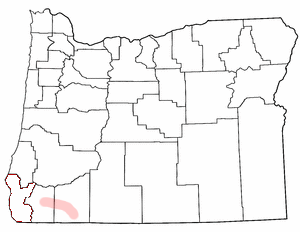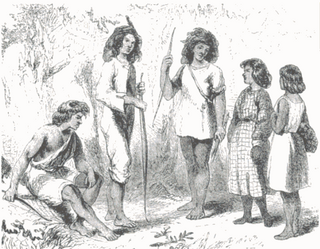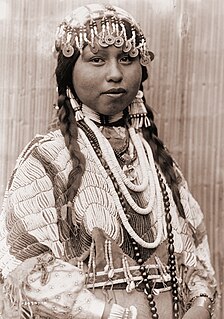Related Research Articles
The Coquille are a Native American people who historically lived in the Coquille River watershed and nearby coast south of Coos Bay. They were signatories of the Oregon Coast Tribes Treaty of 1855 and were subsequently removed to the Siletz Reservation in northwestern Oregon in 1856. Most Coquille people today live there as members of the Confederated Tribes of Siletz Indians, but some whose ancestors remained in the traditional homeland or fled the reservation now make up the Coquille Indian Tribe, centered in southwest Oregon where the Coos River flows into Coos Bay.

The Umpqua people are an umbrella group of several distinct tribal entities of Native Americans of the Umpqua Basin in present-day south central Oregon in the United States. The area south of Roseburg is now known as the Umpqua Valley.
The Tututni tribe is a historic Native American tribe, one of Lower Rogue River Athabascan tribes from southwestern Oregon who signed the 1855 Coast Treaty, and were removed to the Siletz Indian Reservation in Oregon. They traditionally lived along the Rogue River and its tributaries, near the Pacific Coast between the Coquille River on the north and Chetco River in the south. Lower Rogue River Athabascan tribes are a group of Athabascan tribes who were historically located in southwestern Oregon in the United States and speak the same Athabascan language, known as Lower Rogue River.
The Siletz were the southernmost of several divisions of the Tillamook people speaking a distinct dialect; the other dialect-divisions were: Salmon River on the river of that name, Nestucca on Little and Nestucca River and Nestucca Bay, Tillamook Bay on the bay of that name and the mouths of the Kilchis, Wilson, Trask and Tillamook rivers, and Nehalem on Nehalem River. The name "Siletz" comes from the name of the Siletz River on which they live. The origin of the name is unknown
The Takelma are a Native American people who originally lived in the Rogue Valley of interior southwestern Oregon.
The Molala are a people of the Plateau culture area in the Oregon Cascades and central Oregon, United States. They are one of the Confederated Tribes of the Grand Ronde Community of Oregon, with 141 of the 882 members in the 1950s claiming Molala descent. The Confederated Tribes of Siletz Indians also has Molalla representation among its confederation of Tribes and Bands. The Siletz Reservation was established in 1855, for the Coast, Willamette and Umpqua Tribes. The Molalla are one of the Tribes who signed the 1855 Willamette Valley Treaty.
The Shastan peoples are a group of linguistically related indigenous peoples from the Klamath Mountains. They traditionally inhabited portions of several regional waterways, including the Klamath, Salmon, Sacramento and McCloud rivers. Shastan lands presently form portions of the Siskiyou, Klamath and Jackson counties. Scholars have generally divided the Shastan peoples into four languages, although arguments in favor of more or less existing have been made. Speakers of Shasta proper-Kahosadi, Konomihu, Okwanuchu, and Tlohomtah’hello "New River" Shasta resided in settlements typically near a water source. Their villages often had only either one or two families. Larger villages had more families and additional buildings utilised by the community.

The Confederated Tribes of the Grand Ronde Community of Oregon (CTGR) consists of twenty-seven Native American tribes with long historical ties to present-day western Oregon between the western boundary of the Oregon Coast and the eastern boundary of the Cascade Range, and the northern boundary of southwestern Washington and the southern boundary of northern California. The community has an 11,288-acre (45.7 km2) Indian reservation, the Grand Ronde Indian Reservation, which was established in 1855 in Yamhill and Polk counties.

The Rogue River Wars were an armed conflict in 1855–1856 between the U.S. Army, local militias and volunteers, and the Native American tribes commonly grouped under the designation of Rogue River Indians, in the Rogue River Valley area of what today is southern Oregon. The conflict designation usually includes only the hostilities that took place during 1855–1856, but there had been numerous previous skirmishes, as early as the 1830s, between European-American settlers and the Native Americans, over territory and resources.
The Tolowa language is a member of the Pacific Coast subgroup of the Athabaskan language family. Together with three other closely related languages it forms a distinctive Oregon Athabaskan cluster within the subgroup.
The Confederated Tribes of Siletz Indians in the United States is a federally recognized confederation of more than 27 Native American tribes and bands who once inhabited an extensive homeland of more than 20 million acres from northern California to southwest Washington and between the summit of the Cascades and the Pacific Ocean. After the Rogue River Wars, these tribes were removed to the Coast Indian Reservation, now known as the Siletz Reservation. The tribes spoke at least 11 distinct languages, including Tillamook, Shasta, the Clatsop, lower, middle and upper dialects of Chinook, Kalapuya, Takelma, Alsea-Yaquina, Siuslaw, Coos, the Plateau Penutian languages Molala and Klickitat, and several related Athabaskan dialects (Upper Umpqua, Upper Coquille, Sixes/Euchre Creek, Tututni, Chetco, Chasta Costa, Galice/Applegate, Tolowa Oregon Athabaskan languages.
The Coquille Indian Tribe is the federally recognized Native American tribe of the Coquille people who have traditionally lived on the southern Oregon Coast.

Table Rock Reservation was a short-lived Indian reservation north of the Rogue River in Oregon, United States. It was established by treaty with the Rogue River Indians in 1853. Following the conclusion of the Rogue River Wars in 1856, the Native American inhabitants were moved to other reservations. The reservation was in Southern Oregon, between Upper Table Rock and Evans Creek.
Latgawa are Native American people who lived in the Rogue Valley of interior southwest Oregon. In their own language "Latgawa" means "those living in the uplands," though they were also known as the Walumskni by the neighboring Klamath tribe.
The Tillamook are a Native American tribe from coastal Oregon of the Salish linguistic group. The name "Tillamook" is a Chinook language term meaning "people of [the village] Nekelim ", sometimes it is given as a Coast Salish term, meaning "Land of Many Waters". The Tillamook tribe consists of several divisions and dialects, including :

Rogue River Indians are a conglomeration of many tribal groups in the Rogue River Valley area, belonging to three language families: Athabascan, Takelma and Shastan.
The Oregon Superintendent of Indian Affairs was an official position of the U.S. state of Oregon, and previously of the Oregon Territory, that existed from 1848–1873.

The Chetco are a tribe of Native Americans who originally lived along the lower Chetco River and Winchuck River in Curry County in the U.S. state of Oregon. The name Chetco comes from the word meaning "close to the mouth of the Chetco River" in their own language, which is part of the Athapascan languages. Although they were once one of the largest tribes on the Pacific coast of Oregon, "the last known full-blooded Chetco" living on the Chetco River died in 1940.

The Native American peoples of Oregon are the set of Indigenous peoples who have inhabited or who still inhabit the area delineated in today's state of Oregon in the Pacific Northwest region of the United States. While the state of Oregon currently maintains relations with nine federally recognized tribal groups, the state was previously home to a much larger number of autonomous tribal groups, which today either no longer exist or have been absorbed into these larger confederated entities. Six of the nine tribes gained federal recognition in the late 20th century, after undergoing the termination and restoration of their treaty rights starting in the 1950s.

Chief Tecumtum, was the chief of the Etch-ka-taw-wah band of Athabaskan Indians and a leader in the Rogue River Wars. He signed three treaties with the United States between 1851 and 1854.
References
- ↑ "Oregon Indian Reservations in the 1890 Census". Access Genealogy. Retrieved 2012-12-03.
- ↑ "Lincoln County, Oregon". FamilySearch.org. Retrieved 2012-12-03.
- ↑ "Which tribes lived near the Table Rocks?". Oregon/Washington Bureau of Land Management. Retrieved 2012-12-03.
- 1 2 3 Lucille Tisdale. "The Tlegetlinten Site (35CU59) and its place in southwest Oregon prehistory" . Retrieved 2012-12-03.
- ↑ "Oregon History: Indian Wars". Oregon Blue Book. 2012. Retrieved 2012-12-03.
- ↑ Stacy D. Stumbo. "'Holocaust' led to Indian massacre: On a Monday in 1855, the Indians decided they could take no more". The Daily Courier.com. Retrieved 2012-12-03.
- ↑ Ruby, Robert H.; Brown, John A.; Collins, Cary C. (2013-02-27). A Guide to the Indian Tribes of the Pacific Northwest. University of Oklahoma Press. ISBN 978-0-8061-8950-5.
- ↑ Marya Kalugin & Tammy Bick. "Confederated Tribes Of Siletz" . Retrieved 2012-12-03.